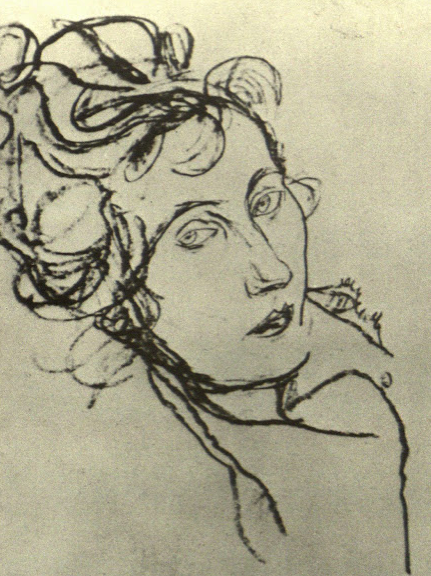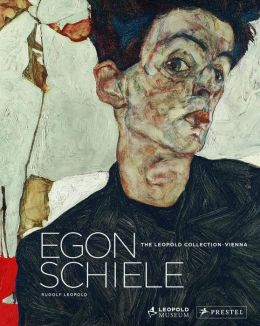October 12, 1997 to January 4, 1998
The emotionally charged art of Egon Schiele (1890-1918), the iconoclastic Austrian Expressionist whose innovative drawing style spawned a radical new pictorial form, was examined in an exhibition at The Museum of Modern Art from October 12, 1997 through January 4, 1998. Comprising some 150 worksmost never before seen in the United States—Egon Schiele: The Leopold Collection, Vienna, traced the artist's brief but remarkably prolific career, from a tormented youth in search of artistic identity to a celebrated and influential artist at the time of his death at age 28.
Schiele's legacy, and his significance to contemporary artists, is an intensely personal figurative art that rejects conventional concepts of beauty in favor of exploring the psychological complexity of his sitters.
Part of the extensive collection of Dr. Rudolf Leopold, a prominent Austrian ophthalmologist who has devoted over four decades to amassing the world's finest private collection of the artist, the works in Egon Schiele: The Leopold Collection, Vienna were not on view again until the year 2002, when they were installed in the yet-to-be-completed Leopold Museum, part of the Museum Quarter in Vienna.
Organized by Magdalena Dabrowski, Senior Curator, Department of Drawings, the exhibition included oils, gouaches, watercolors, and drawings that represent all phases of Schiele's creative output—from the decorative
Self-Portrait with a Palette (1905), produced when he was 15 years old, to the moving
Image may be NSFW.
Clik here to view.

Edith Schiele on Her Deathbed (1918),
a portrait of his wife completed only four days before the artist's own death from the same influenza epidemic.
Much of the artist's oeuvre is autobiographical and self revelatory. Probing self-portraits dominate his work and his subjects include the people closest to him as well as landscapes that were a part of family history and personal experience. Death was a constant presence. Three of his siblings died before Schiele was born, a fourth when he was three years old, all victims of their father's syphilis. In 1904, when Schiele was only 14, his father succumbed to his untreated disease.
As a student, Schiele's early drawing style was skilled but unexceptional, as is evident in Portrait of a Young Girl (1906). In 1907 he met Gustav Klimt, the senior statesman of the Viennese art world who would become the younger man's mentor. Nude Boy Lying on a Patterned Coverlet (1908), with its ornamented drapery, clearly shows Klimt's influence.
The great change in the young artist's work came around 1909, when he began assimilating Auguste Rodin's special manner of "continuous drawing," newly developed near the end of the century. This technique, in which the artist draws without taking his eyes off the model, provided Schiele with the lively line, more emphatic than simple contour, that was to become his hallmark.
Schiele's most startling and evocative images—most often of male and female nudes in unabashedly erotic and contorted poses—challenged established conceptions of portraiture, and even the nature of beauty itself. These complex portraits were a marked departure from Art Nouveau, Jugendstil, and their Viennese counterpart, the Secessionist style, which emphasized the representation of the superficial aspects of beauty. He favored contorted bodies, strange, theatrical poses, and nervous, often jagged contours together with unusual color combinations.
"Schiele is, first and foremost, an exceptionally talented draftsman," remarks Ms. Dabrowski in her catalogue essay. "Even in his paintings the primary emphasis remains the structural element of the composition. His use of color is not for the purpose of modeling, but for the expressiveness."
While less well known than his drawings, Schiele's paintings and landscapes also reflect his own inner conflicts.
Image may be NSFW.
Clik here to view.

In Dead Mother I (1910),
for example, created after a vacation in Krumau, his mother's birthplace, darkness surrounds both the skeletal mother and an infant whose blood-red hands and lips betray Schiele's notion that birth was often synonymous with death.
His landscapes, also set in Krumau, are remarkable for their sober, yet highly expressive quality, in which a lack of color often conveys a bleak, nostalgic mood.
Schiele's most important creative years were between 1910 and 1915. His earlier work of this period includes drawings of the street children who visited his studio and provocative adolescent nudes. This era was dominated, however, by narcissistic and angst filled self-exploration, characterized by portraits of himself, sometimes masturbating.
The diversity of moods inherent in the self-portraits is represented in several examples from the Leopold Collection:
Image may be NSFW.
Clik here to view.

Kneeling Male Nude (Self- Portrait) (1910) is an almost grotesque depiction of an emaciated youth;
Image may be NSFW.
Clik here to view.

Grimacing Self-Portrait (1910) depicts an angry, unkempt, almost depraved visage;
Image may be NSFW.
Clik here to view.

Self Portrait in Shirt (1910) explores the more gentle side of his personality.
The death of Schiele's father and the rejection by his uncle resulted in the creation of double portraits, such as
Image may be NSFW.
Clik here to view.
_-_Google_Art_Project.jpg/593px-Egon_Schiele_-_Self-Seer_II_(Death_and_Man)_-_Google_Art_Project.jpg)
Self-Seer II (1911) in which Schiele provides a second self—doppelgänger—in the guise of a protector or imaginary companion.
The years 1911-12 saw the creation of some of the most provocative female nudes, such as
Image may be NSFW.
Clik here to view.

Black-Haired Girl with Raised Skirt (1911). This period of liberated eroticism coincided with the start of his relationship with a sexually experienced young woman named Valerie Neuzil ("Wally"), who would be his companion and primary model until his marriage in 1915.
The artist's fascination with sex, sexuality, and their repression reveals more of the character of turn-of-the-century bourgeois Vienna than of any personal deviance or perversion. Ms. Dabrowski notes, "Schiele's probing of his psyche situated itself within a more general context of Viennese society's preoccupation with sex, the self, and with his own psychological state as it related to the current Freudian theories of psychoanalysis." His powerful nudes, whose explicit poses suggest sexual invitation and arousal, also spoke to the hypocrisy and censorship that were pervasive in the Viennese establishment.
By 1914 Schiele's fortunes started to change for the better. Professionally, he gained both collectors and commissions. Personally, after his marriage in 1915, his works began to feature more mature, fullbodied women, typified by his wife, Edith. Less erotically aggressive, these models exhibit a new tenderness. Manipulation of the body, however, remains the primary expressive technique, visible in such drawings as Lovers (1914), in which the two figures are almost painfully intertwined.
Despite his short career, Schiele has particular resonance for the contemporary viewer. According to Ms. Dabrowski, "His was an art of individuality and creative originality, focused on communicating the depth of human emotions and the force of human experience. The radicality of his art and his rebellion against the traditional attitudes toward such taboos as sex and sexuality make his art relevant to and appreciated by today's young artists and the public at large."
Publication
Image may be NSFW.
Clik here to view.

Egon Schiele: The Leopold Collection, Vienna, by Magdalena Dabrowski and Rudolf Leopold. 364 pages, 152 color plates, 45 black-and-white illustrations. This is an expanded English language version of a book on the subject. Published by DuMont Buchverlag in association with The Museum of Modern Art